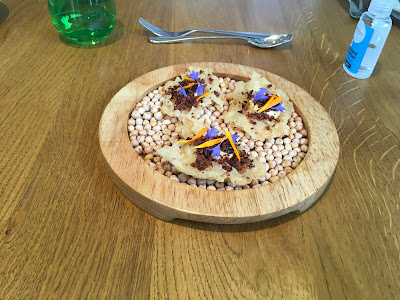A wide entrance glowing with light, with Simpson’s plain to see, on a wrought-iron sign above it ..... for the new Simpson’s, though it retains all its old associations and its old manager and its old head cook .... the polite, little white-haired ruler of the roast, who wears a velvet cap, and who for forty-six years has seen the joints turn before the vast open fire in the kitchen, is now under the rule of the rule of the great organisation that controls .... .
Come into the entrance hall where you where you can give up your hat and coat to an attendant, though if you have been accustomed all your life to take them into Simpson’s you will still find in the dining room stands on which to hang them. The hall, with its marble pillars white panels and groined roof is light and airy, a staircase runs down from it to the smoking-room and another one runs up to the dining rooms upon the first floor.
Through the wide door leading into the dining-room you see the white-jacketed waiters moving hither and thither, and white-coated and white-capped carvers pushing the dinner waggons, crowned with big plated covers, before them and, as a background, the fine fireplace, with its carved wooden overmantel and its little marble pilasters and a picture of a knight and ladyfingers Plantagenet days feasting let into the central space.
 |
| The Gentlemen’s Dining Room, 1918. |
Mr N Wheeler, the rosy-faced manager, white-haired, and wearing the frock coat of ceremony, will probably greet you as you go into the dining-room. he has seen all the changes of Simpson’s ..... and he probably knows more about old English fare than any man living. When we have eaten our turbot and saddle of mutton we will ask how it is that these two best of British dishes are sent to table at Simpson’s in such absolutely perfect condition. But before we choose our seats at one of the tables let us look round the room. The old Simpson’s is still fresh in my memory. The painted garlands of flowers and studies of fish, flesh and fowl on the walls, glazed to a deep rich colour by the London atmosphere, the ground-glass windows, the big bar opening into the room, with Rembrandtesque shadows in its depths; the great dumb waiter, which looked like a catafalque, in the centre of the room; the folded napkins in the glasses on the mantelpiece; the horsehair-stuffed, black-cushioned chairs and benches; the divisions with brass rails and dingy little curtains on the rails. .....
.... In old days the waiters at Simpson’s were mostly British veterans, and in the upstairs room Charles Flowerdew, the head waiter, a genial old soul who always offered his favourites among the customers a pinch from his snuff-box, had a wealth of anecdotes about the great men of the Victorian era who were habitués of Simpson’s. The waiters of today are Britons, but they are young men, and if anyone has any doubts that Englishmen properly trained can be as quick and silent in the service of a dining house as foreigners are, I would advise the doubter to eat a meal at Simpson’s and to watch how the waiters do their work. The boys who take round the vegetables become in time full-blown serving men. The waiters no longer wear the dress-coats, heroes of many clashes with sauce-boats and and plates of soup, which used to be the official garb of the British waiter. They wear white washing jackets, with at the breast a little black shield, and on it the crest of the house - the knight of a set of chessmen. All the tips are pooled, with the result that all the serving men work for the general good.
...... And now to look at the bill of fare. There are no such foreign innovations as hors d’oeuvres, allowed at Simpson’s, where the only concessions to France are in the wine cellar and that little French rolls as well as household bread are in the bread baskets.You can obtain a fish dinner of three kinds of fish for three and nine pence, but we will order just what we feel our appetite demands, and take no account of set dinners. If your taste is for turtle soup, a plate of that luxury will cost you three shillings, but if one of the simpler British soups will content you, hare, pea, mock turtle, Scotch hotch-potch, oxtail, goblet or mulligatawny are priced at one shilling or one shilling and sixpence. Then comes the important question of fish, and the choice really lies between a Sole Souchet, which Simpson’s ought to write Zouchet, boiled codfish and oyster sauce, and boiled turbot and lobster sauce - the last one of the dishes on which Simpson’s prides itself. Until I catted with Mr Wheeler on the subject I understood that a turbot to come to table in perfection should be hung for several days, but Mr Wheeler denounces this as rank heresy. A turbot should be nicked to draw off the blood of the fish, it should be soaked for twenty four hours and then it is ready to be boiled. It is instructive to watch a real habituée of Simpson’s who prefers cod to turbot when a portly white-clad carver wheels his waggon up to the table. There must be the right proportion of liver with the fish and the due quantity of oyster in the sauce, or there will be dire threats of reports to higher quarters. A boiled potato to anyone who knows what is good English fare is not to be accepted without criticism, and he would be a bold carver who dared to give a helping of a saddle of mutton without a slice of the brown. But before we go to the supreme matter of the saddle let me point out to you that whether you eat sole, or cod, or turbot, it means an item of two shillings on the bill.
The joints ring the changes on roast sirloin, boiled beef, boiled leg of mutton, roast loin of veal and bath chap, saddle of mutton, and it is the saddle that is the favourite dish. Forty saddles a day is the quantity consumed at Simpson’s, and now that the new room is opened sixty are required ..... whether you eat the mutton, the beef or the veal, your portion and the accompanying vegetables will cost you half-a-crown.
We will not trifle with such kickshaws as salmi of game, Irish stew, jugged hare, and to finish our dinner we will take a helping of one of the pies or puddings on the bill of fare, or, better still, a good scoop of Stilton cheese or a wedge of Cheshire.
If you wish to be British in your drinking as well as in your eating, there is cool British ale from the cask, which comes to table in a tankard, and cider, and the whisky of Scotland and that of Ireland. The house is also celebrated for its moderately priced Bordeaux and Burgundy wines, bottled in the cellars.
Lt Col Nathaniel Newnham-Davis, The Gourmet’s Guide To London, 1914.
So that was a review of Simpson’s In The Strand by England’s most important early food critic, Nathaniel Newnham-Davis (1854-1917), a notable gourmet with a previous distinguished military career but then retired to a life devoted to seeking out good food in the late Victorian and Edwardian periods and writing about it. Unhappily his reviews were confined to the dining establishments of London and its environs and not to poor old provincial England though Newnham-Davis was happy to travel around Europe and report on the food being served in various countries scattered across the continent. Nevertheless his writing gives us a good idea of what the well heeled Mercian who wanted their wealth and good taste (as judged by themselves) might have been eating at the time in Birmingham and what would have been considered chic to dine on and what would definitely have been naff.
Newnham-Davis combined many of his ‘reviews’ in several books, his first being Dinners And Diners. Where And How To Eat In London (1899). The book was a best seller with a new edition appearing in 1902 and was then followed by A Gourmet’s Guide To Europe, coauthored with the splendidly named Algernon Bastard, published in 1903 with two further editions. Newnham-Davis was the gastronomic correspondent of the Pall Mall Gazette where his articles were first published and as a well-off, life-long bachelor he found it easy to dine at London’s great hotels and restaurants with a number of companions identified only by pseudonyms. In 1914 his book A Gourmet’s Guide To London was published.
A little over a century after the publication of Newnham-Davis’ A Gourmet’s Guide To London and the inclusion of his description of a trip to Simpson’s In The Strand, I found myself lunching the day after my birthday, already celebrated with dinner at Opheem and the following evening at Purnell’s (is it my fault one could barely go out at all to eat in the last fourteen or fifteen months? - there’s a lot of living to make up for and I’m sure Newnham-Davis would have approved), at Simpsons (no apostrophe which drives my spelling checker to distraction) of, er, Edgbaston. Simpsons, with its sheer hoariness (for Birmingham) and Michelin-starred even now after all these years, is of course not unknown to me as no doubt would have been the case with Newnham-Davis had he been a Brummie and born one hundred years later. Indeed it has been host to two vaguely disastrous meals over the years which convinced me that it would surely become unstarred long before now but it seems to have convinced the Michelin inspectors that such an act of degradation was not called for. In case you are wondering, on the first occasion the meal could only be described as so-so and the disagreeable attitude of the then French-accented (faux or otherwise) manager who had clearly worked hard on the ability to look down his own nose combined to delay any possible return and then finally, when it had been refurbished presumably to lower, unhappily, the level of formality in the place but which seemed to result in paralysingly awful, chaotic service and no obvious improvement in the dishes) which seemed to confirm my opinion that Simpsons was incomprehensibly over-rated and would not be a pleasure to revisit for some time to come.
But it was time to forgive and forget and see if the pandemic had stirred the establishment up to new heights or not. And to raise our expectations, a quick review of Simpsons’ (now I can use an apostrophe), history as a gastronomic Shrine of Thomas A Becket in Birmingham told helpfully by the Simpsons’ (another apostrophe) internet website and as succinctly as one might hope any piece of writing would be:-


















No comments:
Post a Comment